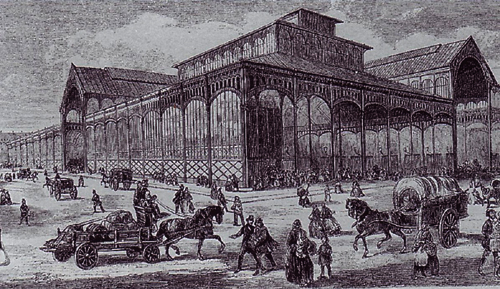My wife grew up in the Centre of Paris and can recall going to Les Halles with her grandmother to gather up leftover flowers from the flower wholesale market. My son played in the parks there every other day, my wife takes a framing course there, and I go shopping in the mall about once a week. All that is to show that Les Halles has been an important part of my neighborhood in Paris, and I care about what happens to it.
Les Halles (The Halls) was the wholesale food market until 1969 when the pressures associated with delivering enough food everyday to feed Paris became overwhelming and a decision was made to relocate the wholesale market to the outskirts of Paris.
The cast iron structures of the old Halls were largely demolished and an enormous hole was dug to construct what would become the central hub of the future RER transportation system.
As Parisians are apt to do whenever a new project is announced, much discussion occurred over the construction details , particularly as far as the public utilization was concerned, to the point that “the hole of the Halls” as it became known remained a hole long enough for a cowboy film to be made in it in 1973. The film, a western farce by Marco Ferreri, starred Marcello Mastroianni , Philippe Noiret and Catherine Deneuve.
Construction was completed in 1977 on Châtelet-Les-Halles, Paris’s new urban railway hub. The Forum des Halles, a partially underground multiple story commercial and shopping centre, opened at the east end of the site in 1979. A public garden covering four hectares opened in 1986. Many of the surrounding streets were pedestrianized.
Today, over 750,000 travellers use the transportation hub daily (RER and Metro combined).
The Forum des Halles is the most frequented shopping mall in the Paris area with over 41 million clients annually. It has 23 cinemas, the busiest swimming pool in Paris, and many public facilities as well as the obvious private ones.
Unfortunately it hasn’t aged well. It leaks. It’s dirty, and the main entrance to the mall is quite frankly ugly. The RER station is overcrowded at peak times, and often confusing.
For those reasons, Les Halles is getting a major make-over. A process which began several years ago with a contest for submissions by architects followed by public forums, some of which I attended.
Demolition began about two years ago and proceeded slowly to avoid disturbing the neighbors too much and also to avoid punching holes in the ceiling of the shops in the mall. (Something which has happened a couple of times but fortunately when the mall was closed.)
The construction phase is well underway now but it’s proceeding slowly. I may be generalizing here, but I can’t imagine a North American construction project of this size bending to so many rules. They can only deliver material at night and only build in the morning. This is why a small army of workers stay right on site. They have installed hundreds of prefabricated apartment units on site for the workers to stay in during the construction process.
Nevertheless, the steel structure for “The canopy”, the leaf-like roof of the main structure is proceeding nicely. I have heard that the structure when completed will use as much steel as the Eiffel Tower, and to look at it, I’d believe it.
If the completed project lives up to the promise of the architectural perspectives, it will be amazing, pricey but amazing. Projected costs for the whole project including the surrounding parks, which will have 138 more trees than before, are currently €802 million.
The whole thing will be finished in 2016, but if you visit Paris before then, come and visit what Emile Zola called the “Belly of Paris” and have a look at the Paris of the future.

David Tovey was born in small town Canada. He still considers himself a country boy at heart, but he’s a cameleon and has been able to adapt to life in Paris, where he has lived for the past 23 years. He has traveled widely, and always listened to his inner voice saying, “Walk down this path,” which has sometimes gotten him into predicaments.
He has worn many hats during his life, one of which was as a freelance journalist, and environmental columnist for the Globe an Mail newspaper in Toronto Canada.









